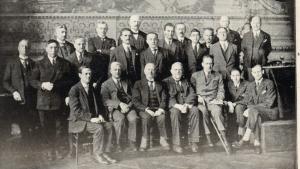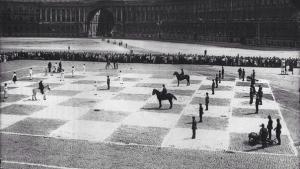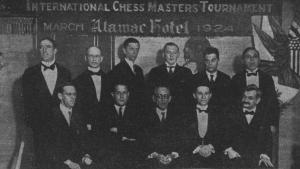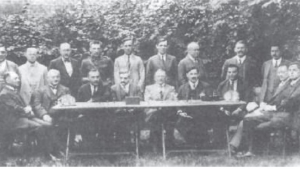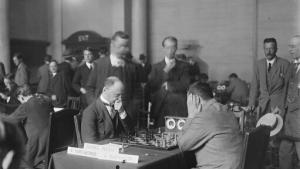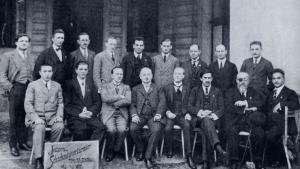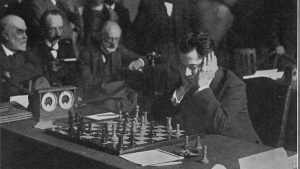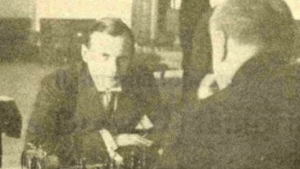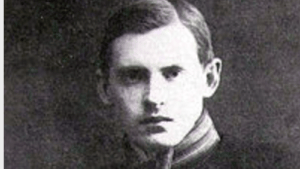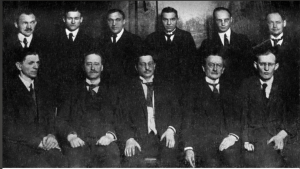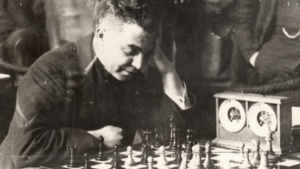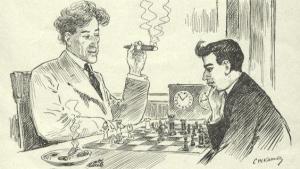
One thing about the history of American chess is that you find yourself reaching for the atlas looking up such unlikely locations as Cambridge Springs, PA, Lone Pine, CA — and also Lake Hopatcong.
Lake Hopatcong turns out to be ...

A surprise for me in playing through the tournaments of the 1920s is how long some of the players I think of as stalwarts of the era took to arrive on the scene. Spielmann was a confirmed middle or bottom-of-the-packer until his breakout at S...

Probably no other chess player has been as consistently amusing to his grandmaster cohort as Rudolf Spielmann. Spielmann was, by all accounts, a very simple person — the last person, really, whom one would expect to be a high-achieving menta...

There is a case to be made that this is the single most significant tournament ever held.
The logic for that argument would run that the defining story of 20th century chess was the creation of the Soviet chess machine, and the Soviet...

Marienbad had the misfortune of being held too close to Baden-Baden. Some of the stronger players were evidently too exhausted to take part, and Marienbad had the ragged feel of an after-party.
It is important in chess history, though...

From a sporting perspective, these were the storylines in chess in the mid-1920s: 1.the invincibility of Capablanca, the question of whether anybody would ever come close to him; 2.the surprising resurgence of Lasker, winning a pair of internation...

Chess in the Soviet Union got off to a slow start. In the 1910s, the Russian Empire had clearly been the coming power in chess, but between the war and civil war virtually all of the leading Russian players — Alekhine, Rubinstein, Nimzowitsc...

This is the quintessential tournament of the decade — much as St Petersburg 1914 is for the 1910s and AVRO for the 1930s. It included all the leading players of the era, with the exception of Rubinstein, and was a thrilling, fast-paced race ...

After his match loss to Capablanca in 1921, it would have been safe to assume that Emanuel Lasker would more or less retire. He was 52, he had always had a challenging relationship to chess competition, sometimes, even at his peak, going years wit...

If there’s a single moment when hypermodern chess crossed over into the mainstream, Carlsbad 1923 is as good a candidate as any. Nimzowitsch appeared in his first major tournament in years displaying his revamped style, which one observer (N...

Aron Nimzowitsch had been an emerging star before the war, finishing shared second at San Sebastián 1912 and qualifying for the elite St Petersburg tournament of 1914 where he failed, however, to make the final round. The war displaced him ...

At his competitive peak in the early 1910s, Akiba Rubinstein was, famously, a pure positional player, the master craftsman of the architecturally-sound position, the high priest of 1.d4, the connoisseur of rook endgames — playing out, in a c...

A real horse race, with five players in contention for first place right up until the last round.
Tartakower was the pace-setter with four straight wins to start the tournament. Spielmann took over at the halfway point and never fully relinquish...

Capablanca at his most machine-like, the feeling of playing against a computer that won’t make a mistake.
His closest call came in the game against Vidmar, a classic of sportsmanship. He had a completely won position at the adjournment. He...

This was effectively a memorial tournament for Gyula Breyer, who had died the previous year. Just before his death he’d suggested reviving the Bad Pistyan tournaments, which had been a feature of the pre-war chess landscape.
Bad Pistyan wa...

A thrilling race between Alekhine and Rubinstein with the atmosphere of a semi-final — a struggle to determine the most likely challenger to Capablanca. Rubinstein had been Lasker’s heir presumptive since 1908 or 1909. He’d been ...

Our last glimpse of Alexander Alekhine has been on the evening of his round 12 game with Milan Vidmar at Mannheim 1914, with Alekhine leading the tournament by a point. With the outbreak of war, he quickly reached Russia and then for some time dis...

Is there any elite player in chess history as overlooked as Efim Bogoljubow?
Bogoljubow quietly emerged in the mid-1910s as an elite player, playing at Mannheim and then sort of captaining the Triberg internees, had a breakthrough in 1920 when h...

Capablanca and Lasker first crossed paths in the mid-1900s when Lasker was living in New York and Capablanca kept drifting away from his New Jersey high school to play chess in the city. Capablanca remembered coming across "a short, middle-aged ma...

Another of the high-class post-war tournaments, the first held in defeated Germany (organized by the indefatigable Bernhard Kagan who somehow kept world-level chess going during the war years). The tournament was almost exactly evenly split betwee...

The first major tournament since before the war and, even more important than that, the breakthrough for hypermodernism. As Jimmy Adams writes, "It is difficult to overestimate the significance of this contest."
It's worth quoting in full ...

The first international tournament of the decade and a nice introduction to three players — two newbies and one returnee.
Richard Réti won the tournament, which was his warm-up for his really startling win at Gothenburg later in the...

Lasker’s career can be thought of in three distinct stages. In the 1890s, he was the usurper — vaulting ahead of other rivals to win his match with Steinitz and never completely convincing the chess world that he was the rightful world...

I’m thrilled to share that my blog A Century of Chess (1900-1909) will be released as a print book by FM Carsten Hansen, with the games annotated by GM Cyrus Lakdawala. This material first found (and continues to find) its home on Chess.com....

Hi!
I have exciting news to share. I've been working with GM Cyrus Lakdawala and FM Carsten Hansen on a book based on A Century of Chess. The book covers chess from 1900-1909 and is a great way to have the series (plus Cyrus' annotati...





